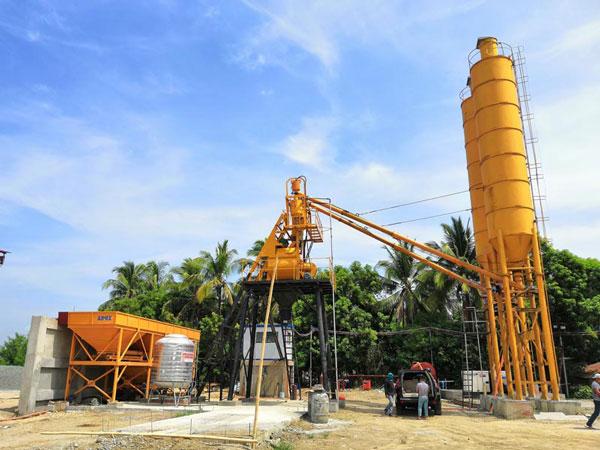A concrete plant, also known as a batching plant or a concrete plant operation, is a facility where various ingredients are combined to produce concrete. This process involves the use of several machines and equipment to ensure efficient and precise concrete production. In this article, we will explore the machines commonly used in a concrete plant and discuss their functions and significance in the overall operation.
The Concrete Batching Machine
The concrete batching machine is a vital component of a concrete plant, responsible for accurately measuring and dispensing the various ingredients required for concrete production. This machine typically consists of multiple hoppers, conveyors, and weighing systems. It ensures the correct proportions of aggregates, cement, water, and additives are used, adhering to the specific mix design.
The batching machine operates based on pre-programmed recipes, which specify the exact quantities of each ingredient. This precision is crucial in achieving the desired concrete characteristics and strength. By automating the batching process, the machine minimizes human error and ensures consistent results.
Aggregate Storage and Handling
Aggregates, such as sand, gravel, and crushed stone, form the bulk of concrete. To accommodate large quantities and different types of aggregates, concrete plants have dedicated storage systems. These systems often consist of multiple bins or silos with various compartments for different aggregate sizes.
The aggregates are stored in these bins or silos until needed. Conveyor belts or bucket elevators transport the aggregates from the storage to the batching machine. By having a well-organized aggregate storage and handling system, concrete plants can efficiently manage different aggregate types and reduce material waste.
Cement Silos and Screw Conveyors
Cement, one of the key ingredients in concrete, is typically stored in silos at concrete plants. These silos are specially designed to keep the cement dry and protected from moisture. A cement silo can have a capacity ranging from a few tons to hundreds of tons, depending on the plant’s production requirements.
To transfer cement from the silo to the batching machine, a screw conveyor is commonly used. The screw conveyor ensures a continuous and controlled flow of cement, preventing any disruptions in the production process. It is essential to maintain the quality and consistency of the cement throughout the operation.
Water and Admixture Dispensers
Water is a critical component in the concrete mix, providing the necessary chemical reaction for the cement to harden and develop strength. Concrete plants are equipped with water dispensers that precisely measure and control the water added to the mix. This ensures the desired consistency and workability of the concrete.
In addition to water, concrete mixes often require admixtures. Admixtures are chemicals added in small quantities to modify the properties of concrete. They can improve workability, accelerate or retard setting time, increase strength, or enhance other specific characteristics. Admixture dispensers in concrete plants accurately measure and introduce these chemicals into the mix, following the predetermined proportions.
Concrete Mixers
Concrete mixers play a central role in concrete plant operation. These machines combine aggregates, cement, water, and admixtures to produce homogeneous concrete. There are different types of concrete mixers used in plants, including drum mixers, pan mixers, and twin-shaft mixers.
Drum mixers consist of a rotating drum where the ingredients are mixed. Pan mixers have a stationary pan and a set of blades that mix the materials. Twin-shaft mixers, as the name suggests, have two parallel shafts with mixing arms that efficiently blend the components. The choice of mixer depends on factors such as the plant’s production capacity and the desired concrete output.
Frequently Asked Questions
1. What is the purpose of a concrete plant?
A concrete plant operation is designed to produce concrete by combining aggregates, cement, water, and admixtures in specific proportions. It provides a controlled environment for efficient and consistent concrete production, ensuring the desired quality and strength.
2. How does a concrete plant work?
In a concrete plant, the various ingredients are accurately measured and dispensed by the batching machine. The aggregates, cement, water, and admixtures are mixed in a concrete mixer to produce the final concrete. The concrete is then transported to the desired location for placement.
3. What are the advantages of using a concrete plant?
Using a concrete plant offers several advantages, including:
– Precise control over ingredient proportions, resulting in consistent concrete quality.
– Increased efficiency and productivity through automation.
– Ability to produce different types and grades of concrete.
– Reduced material waste and improved resource management.
4. How are the ingredients for concrete measured in a concrete plant?
The ingredients for concrete are measured by the batching machine. The machine utilizes weighing systems to accurately measure the quantities of aggregates, cement, water, and admixtures based on pre-programmed recipes.
5. Can a concrete plant be customized for specific project requirements?
Yes, concrete plants can be customized to meet specific project requirements. The capacity, configuration, and additional features of a concrete plant can be tailored to suit the production needs and site constraints of a particular project.
Conclusion
A concrete plant operation relies on various machines to ensure the precise and efficient production of concrete. From the batching machine that measures and dispenses the ingredients to the concrete mixer that blends them into a homogeneous mixture, each machine plays a crucial role. Additionally, systems for aggregate storage, cement silos, water and admixture dispensers further contribute to the overall operation. By understanding the functions and significance of these machines, concrete plant operators can optimize their production processes and deliver high-quality concrete for construction projects.
Read More: concrete mixer 1 bagger for sale Philippine
